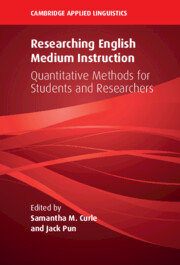Book contents
- Researching English Medium Instruction
- The Cambridge Applied Linguistics Series
- Researching English Medium Instruction
- Copyright page
- Dedication
- Contents
- Figures
- Tables
- Preface
- Acknowledgments
- Notes on Editors
- Notes on Contributors
- An Introduction to Researching English Medium Instruction Using Quantitative Research Methods
- Part I Theoretical Chapters
- 1 Mathematics and Science Learning in Primary and Secondary School EMI Classrooms
- 2 Investigating Differences between Groups
- 3 The Use of Likert-Type Scales in Survey Research Examining Students’ Attitudes, Challenges, and Languages Use in an EMI University in Hong Kong
- 4 Using Systematic Review to Explore Teaching and Learning Issues in the Context of EMI
- Part II Empirical Chapters (Case Studies)
- Index
- References
2 - Investigating Differences between Groups
Using ANOVA in EMI Research
from Part I - Theoretical Chapters
Published online by Cambridge University Press: 14 December 2024
- Researching English Medium Instruction
- The Cambridge Applied Linguistics Series
- Researching English Medium Instruction
- Copyright page
- Dedication
- Contents
- Figures
- Tables
- Preface
- Acknowledgments
- Notes on Editors
- Notes on Contributors
- An Introduction to Researching English Medium Instruction Using Quantitative Research Methods
- Part I Theoretical Chapters
- 1 Mathematics and Science Learning in Primary and Secondary School EMI Classrooms
- 2 Investigating Differences between Groups
- 3 The Use of Likert-Type Scales in Survey Research Examining Students’ Attitudes, Challenges, and Languages Use in an EMI University in Hong Kong
- 4 Using Systematic Review to Explore Teaching and Learning Issues in the Context of EMI
- Part II Empirical Chapters (Case Studies)
- Index
- References
Summary
Given the various differences between learners, teachers, and instructional methods in English Medium Instruction (EMI), a common purpose of EMI research involves investigating the potential variation between groups. The analysis of variance (ANOVA) test is a common technique used to address such a research aim, as it tests whether there are significant differences between the means of different groups. This chapter introduces the ANOVA test to readers by highlighting how it has been used in research within the field of EMI. To illustrate how different forms of the ANOVA test can be employed, the chapter then provides two case studies: (1) the use of a one-way between subjects ANOVA to examine the differences between three groups of students with respect to their perceptions of the role of English in their academic and career goals and comprehension level of EMI courses; and (2) the use of a mixed ANOVA in a quasi-experimental study that examined the differences in pre- and posttest writing performance and academic motivation of two groups provided with different types of feedback. Each of the case studies summarizes the assumptions required for the use of ANOVA, discusses potential problems that may face EMI researchers, and introduces alternative procedures.
Keywords
- Type
- Chapter
- Information
- Researching English Medium InstructionQuantitative Methods for Students and Researchers, pp. 27 - 39Publisher: Cambridge University PressPrint publication year: 2024

